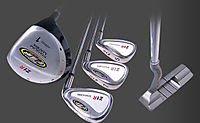Stretching exercises for golfers
Key Points For Effective Stretching
The stretching exercise below are classed as static stretches. Evidence suggests that static stretching should be avoided immediately before competition in favor of a general warm up and dynamic stretching.
1. To increase flexibility and range of motion, perform stretching exercises when the body is warm. This can be at the end of a training session or following 10 minutes of light aerobic exercise.
2. Complete a range of stretching exercises for different muscle groups. Pay particular attention to the muscle groups that are involved most in your sport.
3. Hold each stretch for 10-20 seconds. Initial tightness should gradually diminish as you hold the stretch.
4. Repeat each of the stretching exercises 2-3 times in succession.
5. Perform stretching exercises at least 3 times a week and ideally 5 times per week.
6. Ease slowly in and out of the stretch. Do not bounce! Breathe out as you stretch and continue to breathe as you hold it.
7. If you feel any pain, release the stretch immediately.
Upper And Lower Body Stretching Exercises
shoulder stretching exercises Shoulder Stretch
Interlock your fingers and reach above your head. Your lower back should be flat or slightly arched inwards. You can perform this exercise sitting or standing. Triceps stretching exercises Triceps Stretch
Triceps stretching exercises Triceps Stretch
Place your left hand behind your head and reach as far down your back as possible. With your right hand grasp your left elbow and gently pull it behind the back of your head. You can perform this exercise sitting or standing. Repeat for the other arm. Chest stretching exercises Chest Stretch
Chest stretching exercises Chest Stretch
Clasp your hands behind your back. Gently straighten your elbows and raise your arms as high as comfortably possible. You can perform this exercise sitting or standing. Low back stretching exercises Lower Back Stretch
Low back stretching exercises Lower Back Stretch
Lying flat on your back place the sole of your right foot on your left thigh. Grasp your right knee with your left hand and gently roll it to the left. Try to get your knee as close to the floor as possible without your right shoulder leaving the floor. Groin stretching exercises Groin Stretch
Groin stretching exercises Groin Stretch
Stand with your feet about 2 meters apart, toes pointing forward. Gradually shift all your weight to your right leg by bending your right knee. Your left leg stays straight. Place both your hands on your right knee for support. You can increase the starting distance between your feet for a greater stretch. Groin stretching exercises Groin Stretch
Groin stretching exercises Groin Stretch
Sit down and place the soles of your feet together. Clasp your ankles with your hands so that your elbows rest on your knees. Gently push your knees down with your elbows until your fell the stretch. Quad stretching exercises Quadriceps Stretch
Quad stretching exercises Quadriceps Stretch
Standing upright hold onto a support with one hand (i.e. a chair) for balance. With your other hand clasp your ankle and pull your heel into your butt. Repeat for the other leg. Hamstring stretching exercises Hamstring Stretch
Hamstring stretching exercises Hamstring Stretch
Sitting down, stretch your legs out in front of you while keeping your back flat and upright. Bend your left leg keeping your left foot flat on the floor. Slowly reach forward and try to touch your right toe with both hands. Bend from your waist keeping your lower back flat and your head up. Repeat for the other leg.
Achillies stretching exercises Calf Stretch
Stand arms length away from a wall and with feet shoulder width apart. Place your right foot about 2 feet in front of your left. Keeping both heels flat on the ground lean towards the wall by bending your right knee. Your left leg should stay straight. Push gently against the wall for a deeper stretch. Repeat for the left leg.
Calf stretching exercises Achilles Stretch
This is exactly the same procedure as above except as you lean towards the wall let both knees bend. Rather than leaning forward you should feel like you are lowering yourself straight down. Remember to keep both heels flat on the floor. Repeat for the other leg.
Source















